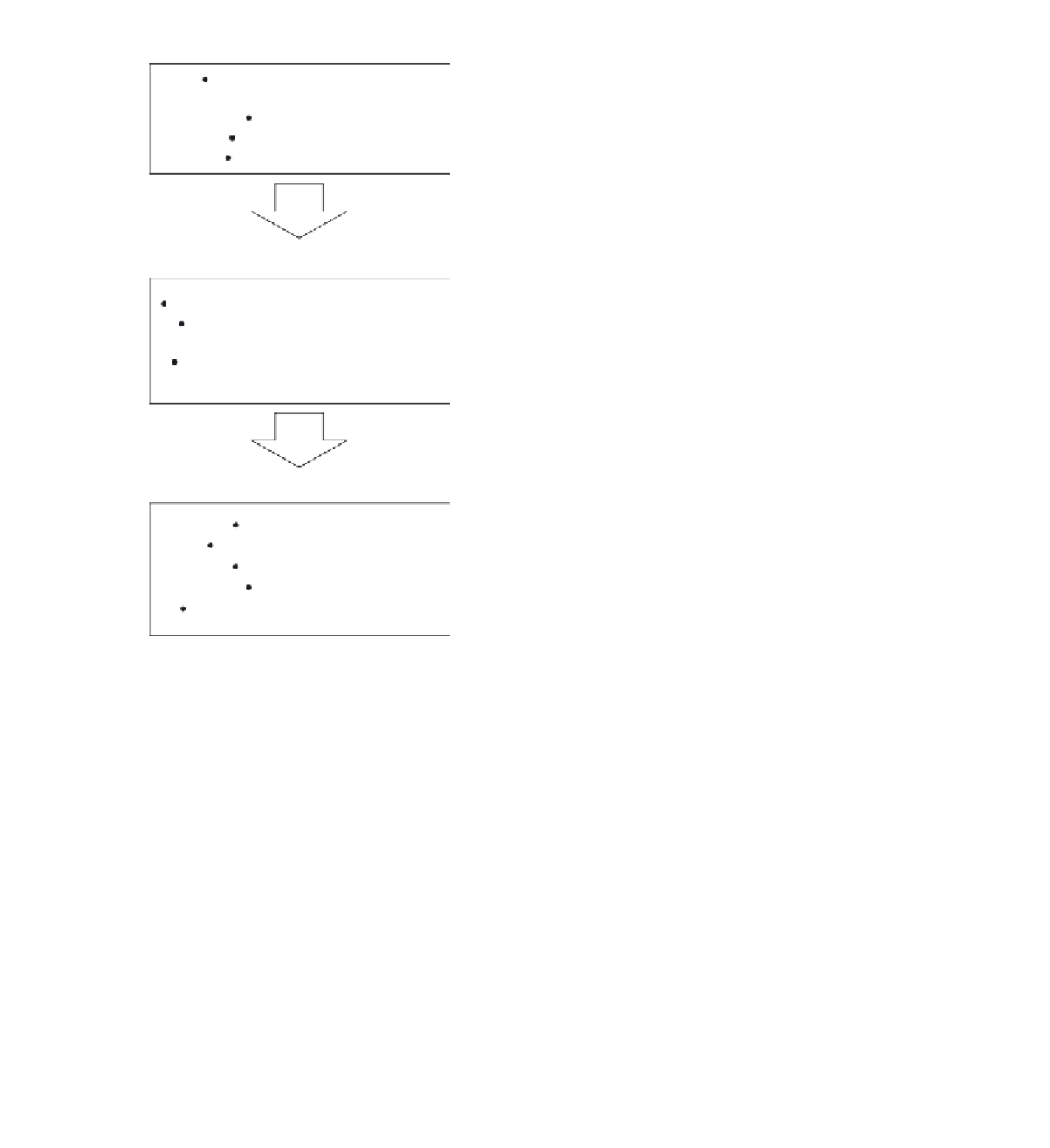Geoscience Reference
In-Depth Information
These mechanisms are not mutually exclusive, as carbon-
ate may be moved laterally into the vicinity of the site of
calcrete formation and then concentrated into particular
horizons by vertical water movements. The importance of
these transfer mechanisms for the formation of the various
calcrete types is discussed below.
Calcium carbonate dissolved in water may be precip-
itated by a variety of processes including evaporation,
evapotranspiration, an increase in pH to above pH 9.0
(Goudie, 1983), a decrease in the partial pressure of CO
2
within the soil or sediment profile (Schlesinger, 1985), a
loss of CO
2
by degassing (e.g. as temperature increases;
Barnes, 1965), freezing (Ek and Pissart, 1965) and the
common ion effect (Wigley, 1973). Organic agency is im-
portant in the formation of some calcretes, with carbonate
fixation driven by the life processes of organisms includ-
ing algae (Kahle, 1977), fungi (Knox, 1977; Verrecchia,
1990; Verrecchia, Dumont and Rolko, 1990; Verrecchia,
Dumont and Verrecchia, 1993), bacteria (Lattman
and Lauffenburger, 1974; Schmittner and Giresse,
1999; Loisy, Verrecchia and Dufour, 1999; Braissant
et al.
, 2003) and cyanobacteria (Verrecchia
et al.
,
1995). Calcrete laminae, in particular, have been sug-
gested to be of organic origin (Klappa, 1979a, 1979b;
Wright, 1989; Verrecchia
et al.
, 1991). The formation of
some calcretes is related to calcite precipitation around
plant roots (Klappa, 1979a, 1979b, 1980; Warren, 1983;
Semeniuk and Searle, 1985; Alonso-Zarza, 1999), but it
is uncertain if this is a widespread phenomenon. Termites
may also fix calcite in soils, as can earthworms and slugs
(Canti, 1998; Monger and Gallegos, 2000).
Pedogenic calcrete formation can take place either
through a simple, progressive process or a more dy-
namic one if carbonate build-up is interrupted by peri-
ods of erosion (Wright, 2007). In the progressive case,
calcrete formation in a carbonate-poor host proceeds via
the downward translocation, precipitation and accumula-
tion of carbonate over time. If the host is carbonate-rich,
this process may involve more complex phases of dis-
solution and reprecipitation. The progressive illuviation
model forms the basis for the time-dependent stages of
calcrete development shown in Table 8.4 and Figure 8.8.
By the time Stage IV of this sequence has been reached,
a profile is effectively plugged by a petrocalcic hardpan
horizon. The subsequent ponding of water above the hard-
pan may promote the development of a laminar calcrete.
Profile formation may also take place by the accumula-
tion of calcified root mats, with rhizogenic calcretes up to
2 m thick formed in this way (Wright
et al.
, 1995). If the
host is carbonate-rich and well indurated, calcretisation
may instead take place along a progressively downward
CaCO
3
Sources
Weathering of minerals in soil
sediment and rock
Dust and rainfall
Vegetation and fauna
Groundwater solutions
Transfer Mechanisms
Lateral, via rivers, lakes and throughflow
Vertical, via capillary rise and water
table fluctuations (
Vertical, via leaching of CaCO
3
inputs
(
per ascensum
)
per descensum
)
Precipitation Mechanisms
Evapotranspiration
Biological 'fixing' of CaCO
3
Common ion effect
CO
2
degassing
Changes in partial pressure of CO
2
Figure 8.10
Sources, transfer mechanisms and factors trig-
gering carbonate precipitation during calcrete development
(after Goudie, 1984).
above (atmospheric dust, rainfall, volcanic ash, sea-spray,
surface runoff, carbonate-rich plant materials and shells)
or below (groundwater and weathered bedrock; see
Goudie, 1983; Cailleau, Braissant and Verrecchia, 2004;
Garvie, 2004). The contribution of specific sources varies
spatially and with calcrete type. Atmospheric dust and
rainfall inputs are of importance for pedogenic carbonate
build-up (Capo and Chadwick, 1999; Chiquet
et al.
, 1999;
Monger and Gallegos, 2000) and subsurface sources crit-
ical for groundwater, valley and channel calcrete devel-
opment (e.g. Arakel and McConchie, 1982; Arakel, 1986,
1991; Nash and McLaren, 2003; Nash and Smith, 2003).
A variety of mechanisms to transfer carbonate to the
site of calcrete formation has been described. These in-
clude vertical transfers within the soil or sediment profile
driven by percolation, capillary rise and watertable fluc-
tuations (the
per ascensum
and
per descensum
models
of Goudie, 1983), and lateral transfers associated with
the movement of carbonate-rich surface or groundwater,

